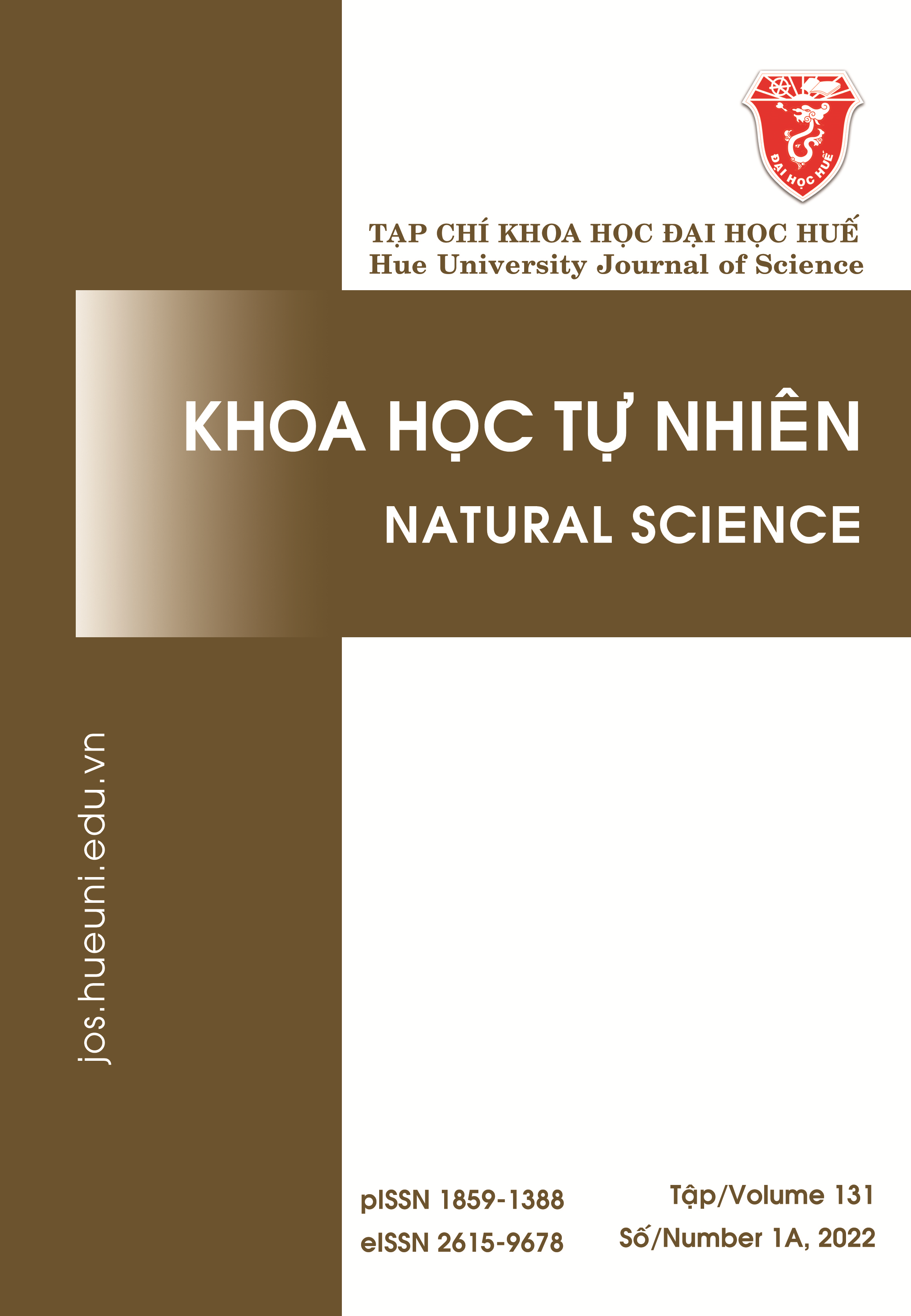Tóm tắt
Trong công trình này, màng tổ hợp của vật liệu graphene (Gr) – ống nano cácbon hai tường (DWCNT) và hạt nano kim loại vàng (AuNPs) (DWCNT-AuNPs-Gr) đã được chế tạo bằng phương pháp lắng đọng pha hơi nhiệt hóa học (CVD). Hình thái học bề mặt và các tính chất điện, điện hóa của vật liệu tổ hợp đã được khảo sát thông qua kính hiển vi điện tử quét phát xạ trường, phổ Raman, điện trở bốn mũi dò và kỹ thuật quét thế vòng (CV). Với nồng độ DWCNTs 0,3 g/L và tốc độ quay phủ 4000 vòng/phút, vật liệu DWCNTs-AuNPs-Gr có điện trở bề mặt giảm 2,3 lần so với màng Gr và đạt khoảng 549 W/sq; dòng đỉnh đáp ứng trong dung dịch 2 mM K3[Fe(CN)6]/K4[Fe(CN)6] trong 0,1 M PBS đạt 15,79 µA tại 50 mV/s, cao gấp 1,48 lần so với điện cực biến tính màng Gr và gấp 2,57 lần so với điện cực trần. Vật liệu DWCNTs-AuNPs-Gr có tiềm năng ứng dụng trong cảm biến điện hóa để phát hiện các phần tử sinh học khác nhau.
Tài liệu tham khảo
- Thanh CT, Binh NH, Van Tu N, Thu VT, Bayle M, Paillet M, et al. An interdigitated ISFET-type sensor based on LPCVD grown graphene for ultrasensitive detection of carbaryl. Sensors Actuators B Chem. 2018;260:78-85.
- Pan H, Li J, Feng YP. Carbon Nanotubes for Supercapacitor. Nanoscale Res Lett. 2010;5(3):654-68.
- Barone V, Hod O, Scuseria GE. Electronic Structure and Stability of Semiconducting Graphene Nanoribbons. Nano Lett. 2006;6(12):2748-54.
- Van Hau T, Van Trinh P, Van Tu N, Duoc PND, Phuong MT, Toan NX, et al. Electrodeposited nickel–graphene nanocomposite coating: influence of graphene nanoplatelet size on wear and corrosion resistance. Appl Nanosci. 2021;1-10.
- Novoselov KS. Electric Field Effect in Atomically Thin Carbon Films. Science (80-). 2004;306(5696): 666-9.
- Treacy MMJ, Ebbesen TW, Gibson JM. Exceptionally high Young’s modulus observed for individual carbon nanotubes. Nature. 1996;381(6584):678-80.
- Thanh CT, Binh NH, Duoc PND, Thu VT, Trinh P Van, Anh NN, et al. Electrochemical sensor based on reduced graphene oxide/double-walled carbon nanotubes/octahedral Fe3O4/chitosan composite for glyphosate detection. Bull Environ Contam Toxicol. 2021;1-7.
- Gan X, Lv R, Bai J, Zhang Z, Wei J, Huang Z-H, et al. Efficient photovoltaic conversion of graphene–carbon nanotube hybrid films grown from solid precursors. 2D Mater. 2015;2(3):034003.
- Van Chuc N, Thanh CT, Van Tu N, Phuong VTQ, Thang PV, Thanh Tam NT. A Simple Approach to the Fabrication of Graphene-Carbon Nanotube Hybrid Films on Copper Substrate by Chemical Vapor Deposition. J Mater Sci Technol. 2015;31(5):479-83.
- Green AA, Hersam MC. Properties and Application of Double-Walled Carbon Nanotubes Sorted by Outer-Wall Electronic Type. ACS Nano. 2011;5(2): 1459-67.
- Dang VT, Nguyen DD, Cao TT, Le PH, Tran DL, Phan NM, et al. Recent trends in preparation and application of carbon nanotube-graphene hybrid thin films. Adv Nat Sci Nanosci Nanotechnol. 2016;7(3):1-10.
- Wang C, Nie X-G, Shi Y, Zhou Y, Xu J-J, Xia X-H, et al. Direct Plasmon-Accelerated Electrochemical Reaction on Gold Nanoparticles. ACS Nano. 2017;11(6):5897-905.
- Sau TK, Rogach AL, Jäckel F, Klar TA, Feldmann J. Properties and applications of colloidal nonspherical noble metal nanoparticles. Adv Mater. 2010;22(16):1805-25.
- Aldewachi H, Chalati T, Woodroofe MN, Bricklebank N, Sharrack B, Gardiner P. Gold nanoparticle-based colorimetric biosensors. Nanoscale. 2017;10(1):18-33.
- Bettazzi F, Ingrosso C, Sfragano PS, Pifferi V, Falciola L, Curri ML, et al. Gold nanoparticles modified graphene platforms for highly sensitive electrochemical detection of vitamin C in infant food and formulae. Food Chem. 2021;344:128692.
- Zalewska A, Krzyminiewski R, Dobosz B, Mrozińska J, Kruczyński Z. The effect of copper ions on interaction of UV radiation with methacrylic matrix - EPR study. Mater Chem Phys. 2013;143 (1):440-5.
- Duoc PND, Binh NH, Hau T Van, Thanh CT, Trinh P Van, Tuyen NV, et al. A novel electrochemical sensor based on double-walled carbon nanotubes and graphene hybrid thin film for arsenic(V) detection. J Hazard Mater. 2020;400(June 2019): 123185.
- Xuan LTQ, Quan TH, Ha TT, Thuan DN. Removal of Rhodamine B Dye By Plasma Jet Oxidation Process. Commun Phys. 2020;31(1):95-102.
- Calizo I, Bejenari I, Rahman M, Liu G, Balandin AA. Ultraviolet Raman microscopy of single and multilayer graphene. J Appl Phys. 2009;106(4): 043509.
- Mondal P, Salam N, Mondal A, Ghosh K, Tuhina K, Islam SM. A highly active recyclable gold-graphene nanocomposite material for oxidative esterification and Suzuki cross-coupling reactions in green pathway. J Colloid Interface Sci. 2015;459:97-106.
- Zhu Y, Murali S, Cai W, Li X, Suk JW, Potts JR, et al. Graphene and Graphene Oxide: Synthesis, Properties, and Applications. Adv Mater. 2010;22(35):3906-24.
- Dou N, Qu J. Rapid synthesis of a hybrid of rGO/AuNPs/MWCNTs for sensitive sensing of 4-aminophenol and acetaminophen simultaneously. Anal Bioanal Chem. 2021;413(3):813-20.

công trình này được cấp phép theo Creative Commons Ghi công-Chia sẻ tương tự 4.0 License International .
Bản quyền (c) 2021 Array




